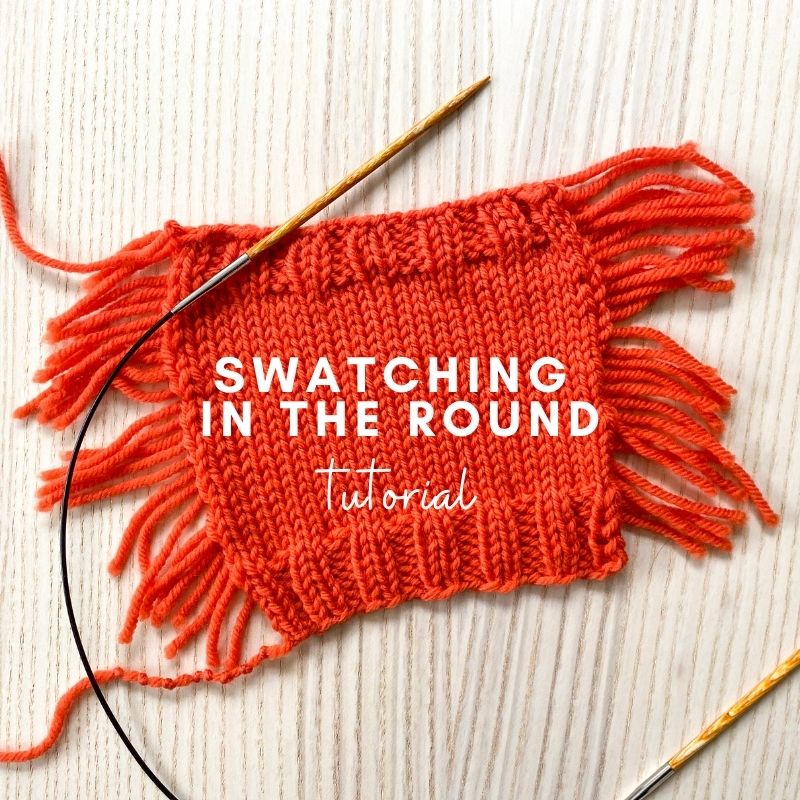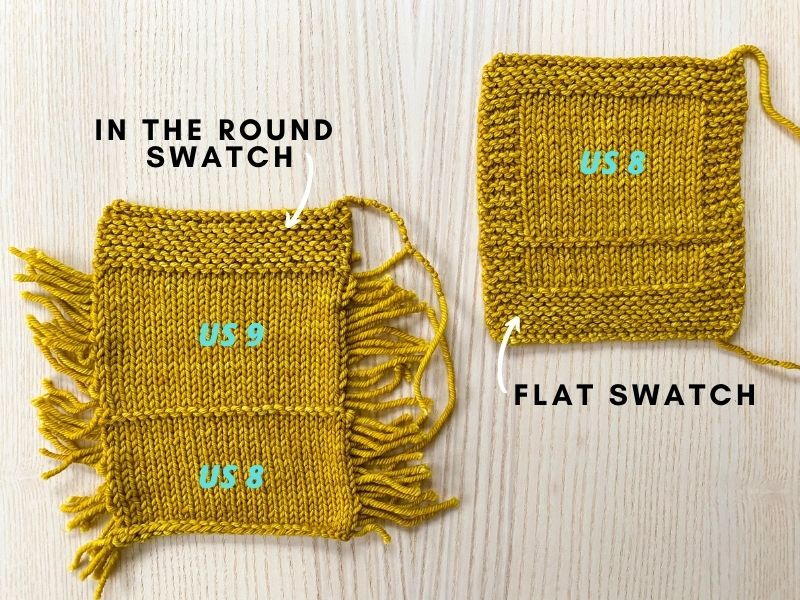Swatching in the Round
Swatching is so important, especially when you are planning to knit a garment, as swatching tells you what needle size you need to use to get the pattern’s specified gauge (and the pattern’s gauge is what determines the finished measurements!), because everyone’s personal tension can be a little different. If you would like to learn more about what gauge swatching is all about, check out my page here. This was a tutorial I created for a sweater knitalong, so although it mentions a specific project the lessons in it are the same regardless of what you are working on. On this page I’m specifically talking about swatching in the round. Keep reading to learn more!
‘Flat’ knitting vs ‘in the round’ knitting
Knitting flat is when you are working back and forth. For example, you knit a row and then when you get to the end of that row you turn the work and purl the next row. When you are knitting flat you are working both RS (right side) and WS (wrong side) rows. Cardigans, scarves and blanket are typically all knit flat.
Knitting in the round is when you are knitting in a circle – and because of this, you are never working a WS row – every row is a RS row! Pullovers and cowls are typically all knit in the round.
Stitch patterns can be different depending on if you’re knitting flat or in the rnd!
When working flat, stockinette stitch is created by knitting on RS rows and purling on WS rows. But in the rnd, because there is no WS row – you are knitting every single round to create stockinette stitch in the round. And this is exactly why you have to swatch in the round if your project is knit in the round. Let me give you a specific example:
- In the above worsted-weight yarn, both swatches are knit in stockinette stitch – the “flat” swatch on the right is created by knitting on RS rows and purling on WS rows and the “in-the-round” swatch on the left is created by knitting every single round (video below to learn how to do this technique!).
- The flat swatch was knit with a US 8 needle to get a gauge of 4.25 sts = 1.”
- For the in-the-round” swatch, I also used the same US 8 needle on the bottom portion but got a gauge of 4.75 sts = 1″ – so my “in the rnd” gauge was tighter than my flat!
- In the top portion of that in-the-round swatch I switched to a US 9 needle and was able to get the 4.25 sts = 1″ gauge. So with the same yarn, I had to bump up a needle size when working in-the-round to get the same gauge as when knitting flat.
This is common for me, and I’ve heard from others it’s common for them too – it turns out, my purl stitches are looser than my knit stitches! It just has to do with my personal tension. So this is why my “flat” stockinette stitch (which involves purling every-other-row) tends to be looser than my “in-the-round” stockinette stitch (which involves NO purling).
So how do you swatch in the round?
Now that I’ve explained why our tension can be different in the round, let’s talk about how you actually create a swatch in the round! In the below video I walk you through the method that I use. The key in this is that we want to mimic the same “in the round” orientation but without having to actually knit a full circle (which would take a lot more yarn). Keep in mind that my swatch in the video is very small and is not what I would typically recommend – I made it small just for demo purposes (so that the video would’t be too long!). The outer edges of an in-the-round swatch should not be included when you measure across your 4″ (see FAQ’s for more details about this):
FAQ’s:
Q: Do I have to cut the strands in the back of the work?
A: I recommend it, especially in case your strands don’t have enough slack and are potentially pulling the work in too much. If you are really nervous about not having enough yarn (and want to re-use the yarn from your swatch for your project), then you can try leaving lots of slack in those strands to avoid any pulling. But my recommended approach is to cut (and then of course measure it, then block it, then re-measure it). But here is one helpful hint – before you cut, do an initial measure of your stitches and at least see if you are in the ballpark. If you are WAY off when measuring this way, there’s probably a good chance you’ll need to swatch on a different needle so you might as well avoid cutting the strands on this swatch and try a different needle size first.
Q: Do the yardage requirements listed in patterns include yarn to swatch, even swatching in the round?
A: I can’t speak to other designer’s patterns but I can tell you that in my patterns I always include enough yardage to swatch.
Q: What if my stitch pattern for gauge is not stockinette stitch?
A: The technique I use above is the same regardless of the stitch pattern you use.
Q: How many stitches should I cast-on when swatching in the round?
A: Typically I want to add extra stitches to each side because I like to measure in the center of my work. So if the gauge listed is, say, 18 stitches & 24 rounds = 4″, I would cast-on at least 28 stitches (so extra 5 stitches on each side). As you see in the above video, your edge stitches will be really loose and I show you how I snug them up a bit, but regardless of whether you leave them loose or snug them, those outer stitches won’t be accurate for measuring gauge so you need to make sure you cast-on enough so that the part of your swatch you are measuring is in the center of the work. Also, in terms of height, I would work until it measures 5″ or so (tip: I usually will knit half of this height and then do a quick measure of my stitch gauge to see if I’m at least close to what the pattern says I should have. If I’m way off, I’ll un-do it and re-start on a different needle size).
Q: What kind of needle should I use for swatching in the round?
A: I like using a 24″ circular needle, but a 32″ will work as well. I recommend using the same type of needle as you plan to use in your project (i.e, if you plan to use a wooden needle for your project, then swatch with a wooden needle tip). I don’t usually recommend using a 16″ circular because the tips are a lot smaller on those than on the 24″ or 32″ and this impacts how you hold the needle (which can thus impact your tension). So unless you plan on knitting the garment on the 16″ needle, I would stick with a 24″ or 32″ instead.
I hope this tutorial has been helpful! If you have any follow-up questions feel free to reach out.


